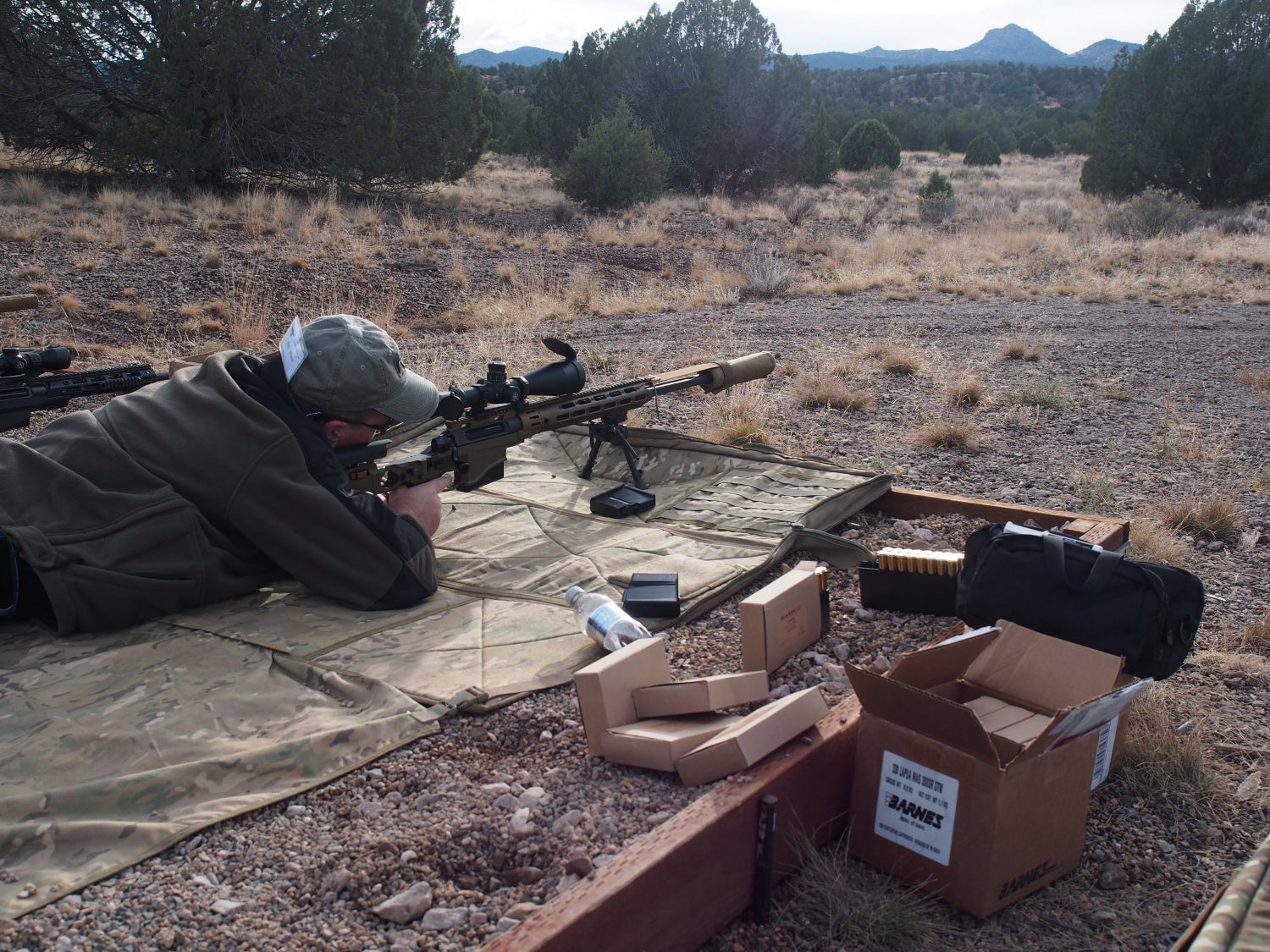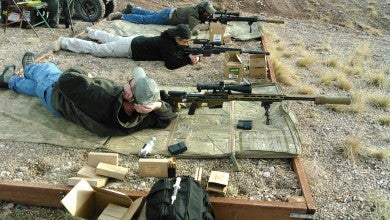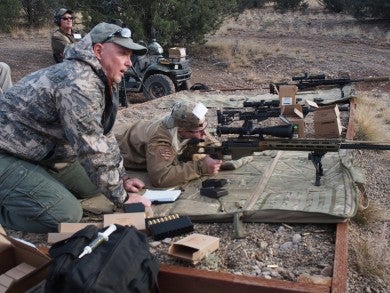The PSR – Precision Sniper Rifle – program has its roots in a 2008 U.S. military market survey, but it really came to life in January of 2009. It was USSOCOM that made the call to replace spec-ops sniper’s current bolt-action sniper rifles, and they wanted it done with a single bolt-action rifle chambered in a Magnum round. Of course, their requirements were a bit more specific than just that.
According to the PSR the rifle should have an overall length of no more than 52” in full configuration, excluding the suppressor, with no single component exceeding 40” in length. As for weight, it was to be measured with a Picatinny rail and an empty 10-round mag; threshold weight couldn’t exceed 18 pounds and objective weight could be no more than 13 pounds. As for performance the rifle – with optics – had to be capable of 1.0 MOA from 300 to 1500 meters “when fired from the shoulder or an accuracy fixture in nominal conditions” (from PSR Synopsis dated February 13, 2009). In addition, MRBF was set at 1000 rounds and the rifle needed to be capable of operator breakdown – into major components – in under two minutes. And, of course, assembly from major components breakdown also needed to be possible in under two minutes, but here’s the thing, it also needed to be assembled from breakdown with no changes in weapon zero. Zero must also be maintained during routine firing, combat movement, and operational training drills. Oh, and the PSR of choice should be capable of changing calibers in the field by swapping one barrel for another. There’s more, but this gives you a decent idea what USSOCOM wanted.
The program’s project manager, Col. Douglas Tamilio, said they’d choose and begin fielding a new rifle within three or four years – that was in April 2011. It didn’t take long for a winner to emerge, though: on March 8, 2013, Remington was declared as the manufacturer of choice with their MSR, Modular Sniper Rifle. It’s a ten-year contract valued at $79.7 million for 5,150 rifles with suppressors and also 4,696,800 rounds, although how many rounds of each caliber isn’t specified.
The MSR meets the PSR requirements, and then some. It’s 36” long with the stock folded and 46” with the stock extended and meets the objective weight right at 13 pounds, coming in just under that 18-pound threshold weight at 17 pounds. The barrels are FNC (ferric nitride carburization) coated and the titanium part of the action is PVD ion-bonded. Those features give it the ability to withstand 96 hours of salt fog testing, which is part of the military requirements. The FNC coating also increases the barrel’s Rockwell hardness to right about 70, which helps extend the barrel life by a third, while the PVD also improves feeding, making the rifle more capable of functioning in rough environments.
As for caliber changes, yes, the MSR can go from one to another in the field in a few simple motions. It takes .338 Lapua Magnum, .300 Win Mag, and .308 Win. To make changing the barrel easier the barrel nut is exposed and has finger grooves to aid in turning, but a torque wrench is typically used for changes because it’s the best – really, the only – way to ensure consistency. When making a caliber change the bolt heads must also be changed (and obviously you’re using a different mag).
For more specs, scroll to the bottom of the article, because now it’s time to hit the range.
During a recent conference with a focus on military and law enforcement firearms we got range time with the MSR, and not just any range time, either, we got to really find out what it can do. The range was fantastic with metal Frankenstein targets (yes, the squared-off man-shaped ones) at intervals. The closest was set to the left at 600 yards away with another to the right at 800 yards – and then, the ultimate goal, sitting on a far-off ridgeline at 1410 yards. The MSR is capable of accuracy at 1500 meters, which is 1640 yards. Unfortunately we didn’t have a range quite that long, but 1410 yards is still an impressive distance, and on that day it was about more than yardage.
We were the last to hit the sniper range that day, and, in fact, our time was nearly cut off due to a number of negative factors. The sun was about to set, which changed the light from good to poor, and it was becoming increasingly windy. And on top of the fading light the angle of the slowly setting sun was creating a glare directly in our field of vision. The circumstances were not ideal, but I wasn’t the only one adamant about trying the MSR along with the two other rifles set up alongside it, so we got to it with the warning that it may not go as well as previously hoped ringing in our ears.
Phil went first, but we were short a spotter so he had to wait a few minutes to start shooting, and I helpfully took a photo of his waiting time (see above). Once he got going, he clearly enjoyed it, and when it came time to make that 1410 yard shot, he rang steel. Of course, one thing Phil and I have in common is our love of the .338 Lapua Magnum, which made the MSR all the more attractive.

To give the reader an idea of distance the first hilltop in the background is where the target is. 1410 yards at the military crest.
The MSR we used was set up for .338 Lapua Magnum with a 27” barrel on a LaRue bipod. It had an AAC Blackout muzzle brake – those are made with aerospace-grade, heat-treated 17-4 stainless steel and Nitride coated – which is compatible with AAC’s suppressors. The suppressor on the MSR was AAC’s TiTAN-QD, which is impressively made. The TiTAN-QD is made of titanium and weighs 50% less than the original Titan and is assembled by CNC automated fusion welding. It features AAC’s patent-pending monolithic Hyposone baffle module, delivers sound suppression of 32dB, and is the suppressor of choice for many of our nation’s most talented snipers (and if you’re wondering about MSRP, it’s $1,995.00).
The stock on the MSR is adjustable from 12.4” to 14.4” and, as usual, a longer LOP suited me best. The cheek was at 1 ¾”. Some adjusting of height was required, but not much, and I was ready to go. The light was definitely not ideal, and I started at the closest target, which was slightly to my left and 600 yards, or 548 meters, out. The first shot rang steel with dead accuracy, so I moved to the next target, which was farther up the rise at 800 yards, or 731 meters, and off to the right. The second shot also rang steel, and I was thoroughly enjoying the MSR despite not having tried to farthest shot yet. The farthest possible shot, and my next target, was 1410 yards out, which is the equivalent of 1289 meters. It wasn’t the 1500 meters needed to fully stretch the MSR’s legs, but it was still a good shot, quite a ways out, and in waning light with cross-winds. It would be a nice test of the rifle.
The first 1410 yard shot took a bit longer to set up, making small adjustments according to the suggestions of my spotter. And then the gentle squeeze of the trigger, and the reward of the bullet striking that far-off Frankenstein target with the promised accuracy. The MSR performed beautifully, not only that, it was fun to shoot, so much so I wish I could have tucked it under my coat and taken it home. There may not be much call for 1410-yard or 1500-meter shots on a daily basis, but I’d figure something out. I took a few more shots at the 1410-yard target before stopping, and I hated having to stop.
The trigger on the MSR is light; it takes only a gentle squeeze to send a round down-range and has a nice return. That trigger is Remington’s M24, which was first made for their M24 Sniper Weapon System, and it’s adjustable from 3.5 to 5.0 pounds. I prefer lighter triggers, and this was excellent, set at 4 pounds. It also has a wide shoe for easier use with gloves, and I find that broader surface also allows for more careful distribution of pressure. The bolt worked smoothly and the handle was large enough to allow for a firm, comfortable grip. As for the stock, it fit my shoulder nicely; its size gave me the impression of a having a good, solid connection to the rifle and the butt was perfectly comfortable tucked against me.
A word about optics. The optic on this MSR was the Leupold Mark VIII 3.5-25x56mm MB52 Front Focal. It’s an amazing rifle scope and allowed for accurate, delicate adjustments, and the eye box is large, which I liked. Its actual magnification ranges from a low of 3.50x to a high of 25.00x with eye relief in inches from 3.70” to 3.30”. Linear field of view by ft/100 yard is 32.50ft to 4.40ft, or, in m/100m, 10.80m to 1.60m. Its elevation adjustment range is 90.00moa and windage adjustment range is 50.00moa. The scope weighs 37.00 ounces and is 16 inches long. Phil praised the scope for its impressively clear glass and I liked the appearance of the Horus Reticle System (yardage and rangefinder values stay the same with all levels of magnification) and how easily I was able to make minute adjustments. Due to the significant distance the scope was set to 25x on the MSR, and it more than did its job. It’s a top-of-the-line scope, as reflected by its MSRP of $5374.99.
An extra feature is spacers for between the butt pad and stock for snipers with a longer reach. All barrels are fluted, and all calibers come in all barrel lengths. The MSR also has the option of a barrel for .338 Norma Magnum, which was not a part of the military PSR. When these rifles are purchased by the military or law enforcement they cost about $15,000 each, and that’s without optics.
The Remington MSR is a stellar long-range rifle, and it’s easy to see why it was chosen as the winner of the PSR program. Phil and I both enjoyed it, and I know I could have easily kept shooting. In fact, of the various rifles I shot prone during the conference, this MSR was my favorite. I’ve fired a .338 Lapua-chambered rifle before without the bells and whistles – and loved it – and received the far more sizable glory of its recoil, and with its .338-barrel on, the MSR gave a surprisingly gentle performance in comparison. This is a superior sniper rifle, and it’s my hope the guys overseas are able to score some nice hits using the MSR’s ordered for them by the military.
| Caliber | 338 Lapua Magnum, 338 Norma Magnum, 300 Winchester Magnum, 308 Winchester (7.62×51 NATO). |
| Receiver | Remington MSR Action |
| Barrel | 20″, 22″, 24″, 27″, Stainless Steel, Modified for AAC Black out Flash suppressor and Titan suppressor, Various twists depending on caliber |
| Suppressor | Advanced Armament Corporation (AAC) Titan, Quick Detach |
| Trigger | Remington M24, Adjustable 3.5 – 5lbs |
| Stock | Remington MST Chassis, Full aluminum chassis |
| Magazine | 338 LM – 5 & 10 rd detachable, 338 Norma – 5 & 10 rd detachable, 300 WM – 7rd detachable, 308 Win – 5 & 10 rd detachable |
| Bipod | LaRue/Harris LM-S |
| Optics | S&B PM II, 5-25X, 1st Focal Plane HORUS reticle |
| Rings | Remington UNI-mount |
| Optics Base | Integral Picatinny rail, Side Rails |
| Weight | Base Rifle – 13 lbs, Complete – 17 lbs |
| Length | Stock extended (w/22″ barrel) – 46″, Stock folded (w/22″ barrel) – 36″ |
| Variations | Rifle only (1 caliber), Rifle only (2 calibers), Rifle only (all calibers), Complete system (1 or multiple calibers) |
| Accessories | Hard case, Soft case, Tool kit, Operators Manual |
| Options | Armorers kit, Spares, As required by the customer |
 Your Privacy Choices
Your Privacy Choices





